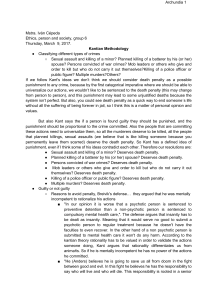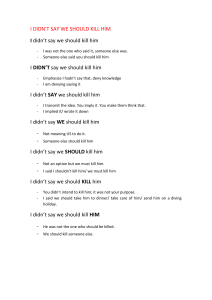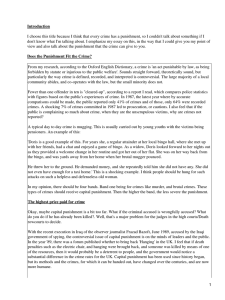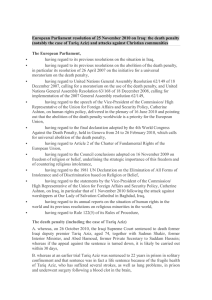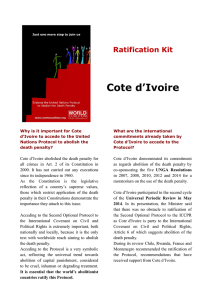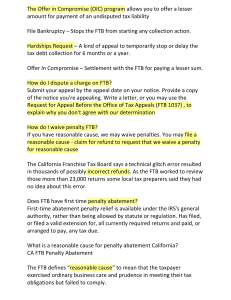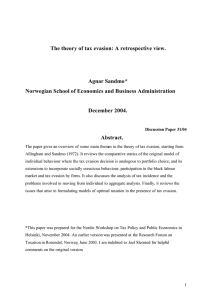Death penalty
Anuncio
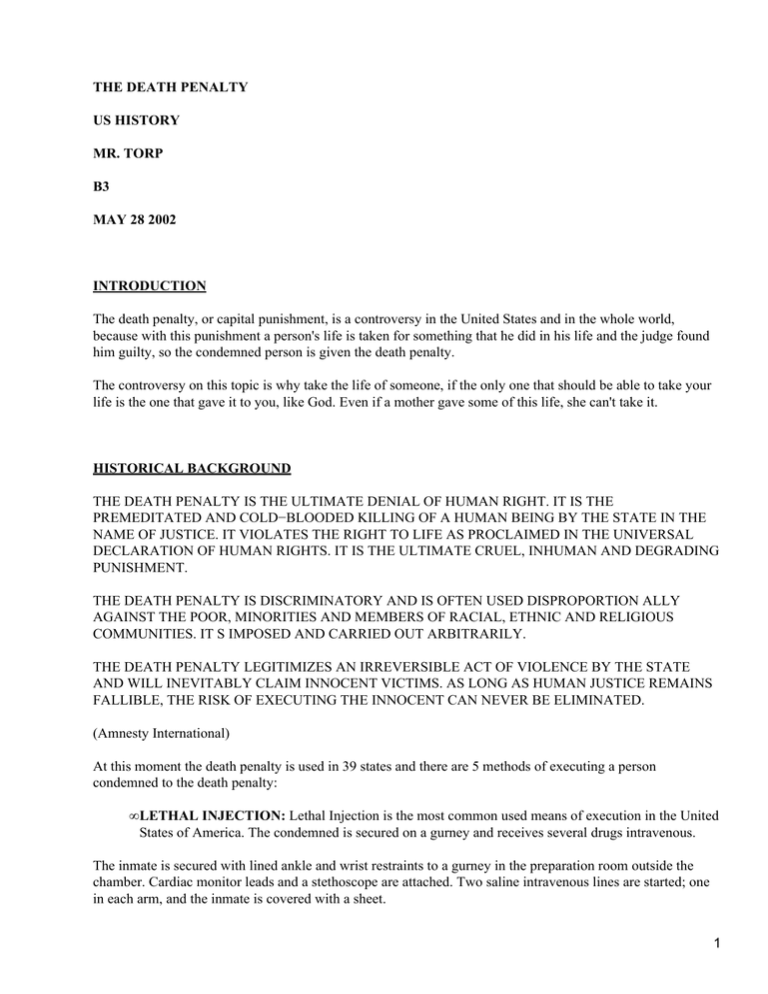
THE DEATH PENALTY US HISTORY MR. TORP B3 MAY 28 2002 INTRODUCTION The death penalty, or capital punishment, is a controversy in the United States and in the whole world, because with this punishment a person's life is taken for something that he did in his life and the judge found him guilty, so the condemned person is given the death penalty. The controversy on this topic is why take the life of someone, if the only one that should be able to take your life is the one that gave it to you, like God. Even if a mother gave some of this life, she can't take it. HISTORICAL BACKGROUND THE DEATH PENALTY IS THE ULTIMATE DENIAL OF HUMAN RIGHT. IT IS THE PREMEDITATED AND COLD−BLOODED KILLING OF A HUMAN BEING BY THE STATE IN THE NAME OF JUSTICE. IT VIOLATES THE RIGHT TO LIFE AS PROCLAIMED IN THE UNIVERSAL DECLARATION OF HUMAN RIGHTS. IT IS THE ULTIMATE CRUEL, INHUMAN AND DEGRADING PUNISHMENT. THE DEATH PENALTY IS DISCRIMINATORY AND IS OFTEN USED DISPROPORTION ALLY AGAINST THE POOR, MINORITIES AND MEMBERS OF RACIAL, ETHNIC AND RELIGIOUS COMMUNITIES. IT S IMPOSED AND CARRIED OUT ARBITRARILY. THE DEATH PENALTY LEGITIMIZES AN IRREVERSIBLE ACT OF VIOLENCE BY THE STATE AND WILL INEVITABLY CLAIM INNOCENT VICTIMS. AS LONG AS HUMAN JUSTICE REMAINS FALLIBLE, THE RISK OF EXECUTING THE INNOCENT CAN NEVER BE ELIMINATED. (Amnesty International) At this moment the death penalty is used in 39 states and there are 5 methods of executing a person condemned to the death penalty: • LETHAL INJECTION: Lethal Injection is the most common used means of execution in the United States of America. The condemned is secured on a gurney and receives several drugs intravenous. The inmate is secured with lined ankle and wrist restraints to a gurney in the preparation room outside the chamber. Cardiac monitor leads and a stethoscope are attached. Two saline intravenous lines are started; one in each arm, and the inmate is covered with a sheet. 1 • Sodium Thiopental causes unconsciousness. • Pancuronium Bromide stops respiration. • Potassium Chloride stops heart. The saline intravenous lines are turned off and the thiopental sodium is injected which puts the inmate into a deep sleep. A second chemical agent, procuronium bromide (the generic name for Pavulon), follows. This agent is a total muscle relaxer. The inmate stops breathing and dies soon afterward. States using Lethal Injection: Arizona, Arkansas, California, Colorado, Connecticut, Delaware, Idaho, Illinois, Indiana, Kansas, Kentucky, Louisiana, Maryland, Mississippi, Missouri, Montana, Nevada, New Hampshire, New Jersey, New Mexico, New York, North Carolina, Ohio, Oklahoma, Oregon, Pennsylvania, South Carolina, South Dakota, Tennessee (staring Jan 1, 1999), Texas, Utah, Virginia, Washington, Wyoming, U.S. Military, U.S. Government. • ELECTROCUTION: Electrocution produces visibly destructive effects as the body's internal organs are burned; the prisoner often leaps forward against the restraining straps when the switch is thrown. The body changes color, the flesh swells and may even catch fire. The prisoner may defecate, urinate or vomit blood. Witnesses always report that there is a smell of burning flesh. States using Electrocution: Alabama, Arkansas, Florida, Georgia, Indiana, Kentucky, Nebraska, Ohio, Oklahoma, Rhode Island, South Carolina, Tennessee, Virginia. • GAS CHAMBER: The prisoner is restrained in a hermetically sealed steel chamber, below which is a pan. Upon a signal, the executioner opens a valve, flowing hydrochloric acid into the pan. On a second signal, about 8 ounces of potassium cyanide crystals or tablets are dropped mechanically into the acid, producing hydro cyanic gas, which destroys the ability of blood hemoglobin to perform. (The root word of cyanide, CYAN, denotes a blue color, descriptive of the body's hue). Unconsciousness occurs within a few seconds if the prisoner takes a deep breath, and longer if he or she holds their breath. Death usually occurs within six to eighteen minutes. After pronouncement of death, the chamber is evacuated through carbon and neutralizing filters. Gas−masked crews decontaminate the body with a bleach solution and out gassed prior to release. An unwary undertaker could be killed if this is not done. States using Gas Chamber: Arizona, California, Maryland, Mississippi, Missouri, North Carolina, Wyoming. • HANGING: The prisoner is weighed prior to execution. The "drop" is based on the prisoners' weight, (tables were developed in England during the 1800's) to deliver 1260 foot−pounds of force to the neck. Essentially, the prisoners weight in pounds is divided into 1260 to arrive at a drop in feet. This is to assure almost instant death, a minimum of bruising, and neither strangulation nor beheading. Properly done, death is by dislocation of the third or fourth cervical vertebrae. The familiar noose coil is placed behind the prisoner's left ear, so as to snap the neck upon dropping. States using Hanging: 2 Delaware, Montana, New Hampshire, Washington. • FIRING SQUAD: There is reportedly no protocol for the procedure, which according to information involves a five man team, one of who will use a blank bullet so that none of them knows who was the real executioner. States using Firing Squad: Idaho, Oklahoma, Utah. The total executions made by the United States since 1976 are 618, the state that have done more executions is Texas with 209 executions, and the years with more executions is 1999 with a total of 98 executions. There are 11 states that don't have death penalty are: Alaska, Washington DC, Hawaii, Iowa, Maine, Massachusetts, Michigan, Minnesota, North Dakota, Vermont, West Virginia, Wisconsin. PRO ARGUMENTS There are some arguments in favor of the death penalty. • People who do something very wrong have to pay with something serious, and it should be with the death penalty. • There are people who are so bad that its better to have them dead than alive, because they could be so dangerous that if they were in jail, they might escape, so it is better to kill them. CON ARGUMENTS Some of the reasons against the death penalty are: • It is do ironic that they give the death penalty to someone who kills another person. But what happens when you kill a person? Somebody will kill you because you deserve that. So that means that the other person who will kill you for killing someone deserves to die to. • Some ways that the states use to kill people are barbaric ways. • Any body has the right to take the life of anybody, under these conditions. • Maybe when they condemn someone and later they kill him or her, they probably could be innocent and they are taking the life of an innocent person. CONCLUSIONS I do not really agree with just one opinion because I think that capital punishment is a very important problem because, if for some reason in this world, someone makes a mistake and he or she feels sorry for doing that, I think they deserve another opportunity, but in some cases there are really bad people. I think that condemning them to death is not the perfect punishment because they just die, and I think that they have to suffer at least a little. 3 BIBLIOGRAPHY METHODS OF EXECUTION http://www.agitator.com/dp/methods/index.html (19 Aug. 1999) DEMOGRAPHICS OF THE DEATH http://www.sun.soci.nui.edu/~critcrim/dp/states/using.txt (1996) AMNESTY INTERNATIONAL http://web.amnesty.org/ai.nsf/Index/ACT500012000 (4 Dec. 2000) EXECUTION IN THE U.S. SINCE 1976 http://sun.soci.nui.edu/~critcrim/dp/faq/howmany−00.htmal (3 Mar. 2000) 2 4

